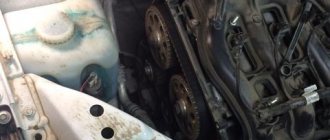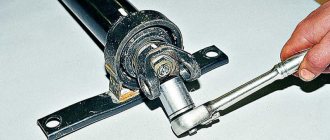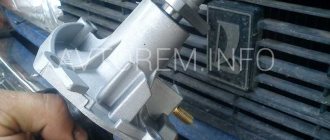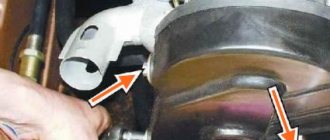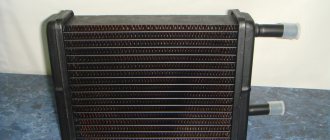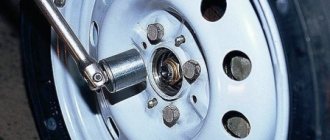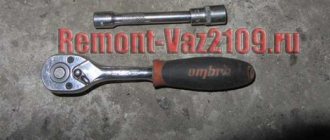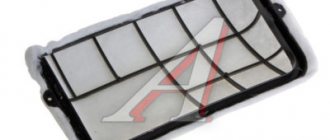A malfunction of the VAZ 2107 , or water pump, can be expressed in two malfunctions: the formation of a coolant leak and the appearance of a hum or detonation. The first fault requires immediate replacement, since a gradual leak of coolant can lead to overheating or even seizure of the engine. A humming noise is the first sign of bearing damage and can eventually cause the pump to stop working. The consequence of this, as in the first case, may be overheating of the VAZ 2107
. So replacement is only a matter of time and should not be carried around.
To perform shift work, a minimum of tools are required:
- 8 keys;
- Key. 10;
- Key. 13;
- Key to 17;
- Screwdriver;
- Tank for collecting coolant.
Spare parts and materials should be stored with the new pump and coolant as they will need to be topped up or replaced during operation. When choosing a new pump, it is recommended to buy a factory-made VAZ. Others may be of inferior quality, and the result may be that money and time have been wasted and a new replacement will soon be needed.
Having collected everything you need, you can proceed directly to replacing the VAZ 2107
. The procedure is not complicated, it is accessible even to a novice car enthusiast. By taking advantage of this opportunity, you can also replace the coolant in the system. You'll first need to drain the coolant from the engine block, or the entire system if you do decide to replace it. To do this, unscrew the bolt from the block (and the radiator if a complete replacement is performed) after removing the plug on the radiator.
Then, using a 17 wrench, loosen the generator tension nut and remove the drive belt from the pump pulley.
Using the same key, we unscrew the fastening bracket to 17. After this, holding the pulley with a screwdriver, we unscrew the three fastening bolts and remove it from the shaft.
Finally, loosen the four bolts holding the pump to the engine block.
Now nothing holds it anymore, feel free to remove the pump from the VAZ 2107 . Before installing a new one, clean the seat from grease. Also be sure to replace the gasket when installing a new pump, otherwise you will have to repeat the entire procedure again. To ensure a sealed system, it is highly recommended to apply a gasket sealant.
Installation of a VAZ pump 2107
carried out in reverse order. There shouldn't be any difficulties during the assembly process. The only thing you should pay special attention to. This is the tension of the alternator drive belt. A belt that is too tight can quickly fail, while too little tension can cause the belt to slip and lead to loss of charge or overheating of the engine.
At the end of the procedure, the coolant must be filled. Be sure to open the heater valve to prevent air from collecting in the cooling system. Fill the fluid to the desired level, start the engine and warm it up to operating temperature. After leaving some time to work, turn off the engine and let it cool, add the missing volume. Also check the tightness of the newly installed pump and the belt tension. After this, the VAZ 2107 is completely ready for use.
Source
VAZ 2107
. a very popular car due to its unpretentiousness and ease of operation. However, this machine has many components that require periodic maintenance or repair, and the pump is one of them.
Pump VAZ 2107
On cars with a liquid cooling system, including the VAZ 2107 , one of the main elements responsible for maintaining the operating temperature of the engine is the pump. Thanks to this unit, the coolant circulates. If there are problems or if the water pump fails, the normal operation of the power unit is disrupted, which can lead to serious consequences and expensive repairs.
Business date, meeting
The pump is designed to continuously circulate coolant (coolant) through the engine cooling jacket. Antifreeze is heated under the influence of the abrasive elements of the power unit, and the necessary pressure in the system is created by a water pump. The liquid is directly cooled in the main radiator, after which the coolant flows back into the cooling housing. If circulation is interrupted for at least 5 minutes, the engine will overheat. This is why it is so important to ensure the correct operation of the relevant unit.
Pump design
On the VAZ 2107 , as on many other cars, the pump has almost the same design. The assembly consists of a housing with a central shaft located inside, on which the impeller is mounted. The shaft is secured against axial movement using a bearing, and the tightness of the structure is ensured by an oil sealant that prevents coolant leakage. The pump cover has a hole through which the shaft comes out, where the pulley hub is attached to it, and then the pulley itself. The latter wears a belt that rotates the generator and crankshaft pump on the “seven”. On modern cars, the pump rotates through the timing belt.
Where
In classic Lada models, the pump is located on the front of the power unit and is not attached to the unit, but through a separate housing. When you open the hood, you can easily notice both the pump pulley and the assembly itself.
Which pump is better
Water pumps with catalog numbers 21073-1307010, 2107 -1307011-75 and 2123-1307011-75 are suitable for VAZ 2107
. The last two options have a larger impeller and a slightly reinforced structure. Initially these pumps were made for Niva. The slightly higher cost of such pumps is justified by better characteristics.
This product is currently produced by many companies, but the most popular are:
- luzar;
- Hepu;
- MAL;
- Phenoxite.
The pump can be purchased either complete with a housing or separately. If the housing is not damaged, it is enough to replace the pump part. If the design has serious defects or even breakdown, then it is impossible to do without replacing the housing.
Video: which pump to install on the “classic”
Engine cooling system pump (pump) for VAZ 2108, 2109, 21099 cars
The engine cooling system pump (pump) of VAZ 2108, 2109, 21099 cars is designed to ensure forced circulation of coolant.
Engine Cooling Pump Location
The coolant pump is installed on the front of the car engine block. There is a gasket and a rubber O-ring between the pump and the block. It is secured to the cylinder block with three 10mm wrench bolts. Removing the pump is not difficult.
Pump device
See “Diagram, engine coolant pump 2108. 2109- pump”.
— The engine cooling system pump (pump) of VAZ 2108, 2109, 21099 cars and their modifications has a housing made of aluminum alloy.
— A steel shaft is installed inside the housing, which rotates in a double-row ball bearing. A cermet toothed pulley is pressed onto the front part of the shaft, and the rear impeller is pressed onto it.
— The bearing does not have an inner race (its role is played by the shaft itself) and is locked in the housing with a screw. The screw socket is hammered to prevent loosening. The bearing is filled with Litol-24 lubricant, which is intended for its entire service life (100,000 km).
— To ensure the tightness of the pump from the impeller side (hardened at the end with high-frequency currents to a depth of 2-3 mm), an oil seal is pressed into the housing to prevent coolant leakage. The seal ring is made of graphite composition.
Operating principle of the coolant pump
The pump is driven by a timing belt through a toothed pulley, so its impeller blades rotate constantly, driving coolant from the supply pipe into the engine cooling “jacket” and then throughout the entire cooling system.
Applicability of the coolant pump on VAZ 2108, 2109, 21099 cars
On VAZ 2108, 2109, 21099 cars, a coolant pump (pump) 2109-1307010 or its analogues from different manufacturers is used.
Pump malfunctions
— Coolant leak
When the oil seal or bearing wears out (the pump shaft begins to “beat”), the shaft-oil seal depressurizes and, as a result, coolant leaks from the engine cooling system along the pump shaft. Leaking liquid is visible visually. In this case, there is also a constant drop in the level in the expansion tank.
— Pump jamming
If the bearing on which the pump shaft rotates fails, it may jam, which leads to the timing belt breaking. It is necessary to periodically check the shaft play. To do this, you will have to remove the front timing belt cover and forcefully rock the pump shaft by the toothed pulley with your hand. In a working pump there should be no play.
A failed pump shaft bearing produces increased noise, which is clearly audible when the engine is idling.
— Reduced efficiency of coolant circulation
If the supply pipe is contaminated (for example, with residues of sealant used during repairs), the efficiency of coolant circulation may decrease. The same effect will occur if the pump impeller is destroyed (for example, when using low-quality, too aggressive antifreeze). The car engine is overheating. Antifreeze may boil.
Notes and additions
— The water pump can be repaired by pressing the impeller, pulley, and unscrewing the bearing retaining bolt. Most often the bearing and seal are replaced. But, it is easier to save time and labor costs and replace the entire faulty pump, since it is not so expensive.
More articles on the engine cooling system of VAZ 2108, 2109, 21099 cars
— Diagram of the cooling system of the carburetor engine of VAZ 2108, 2109, 21099 cars
— Checking the efficiency of the thermostat of the engine cooling system of VAZ 2108, 2109, 21099 cars
— The car engine does not warm up, reasons
— Scheme for switching on the radiator fan of the cooling system of VAZ 2108, 2109, 21099 cars
— Sensor for turning on the radiator fan of the carburetor engine cooling system of VAZ 2108, 2109, 21099 cars
Symptoms of Pump Failure
Sooner or later problems arise with the pump and the unit fails. This may be due to both the high mileage of the car and the installation of low-quality products. Therefore, you need to think about what problems may arise with the pump and what to do in this or that case.
Seal leak
It is easy to detect a coolant leak through the oil seal: a puddle usually appears under the car. If the sealing element is damaged, for example due to wear, antifreeze will enter the pump bearing, causing oil to be washed out of the device, and the part itself will soon be destroyed. To prevent this from happening, it is necessary to periodically inspect the car and eliminate possible problems.
Noise
If unusual noise is heard from the pump area while the engine is running, this indicates rapid failure of the unit. The most likely cause of the noise. bearing failure or incorrect installation of the impeller. In any case, the part must be dismantled and later repaired, repaired or replaced.
Video: how the pump makes noise on a VAZ
Performance degradation
Whatever antifreeze is used in the cooling system, it is chemical. Over time, erosion occurs in the pump housing or impeller, which can reduce the flow of pumped fluid. As a result, the engine may overheat with all the ensuing consequences. Therefore, if the coolant temperature sensor on the dashboard begins to exceed 90 ° C (operating temperature), it is worth considering a possible replacement of the pump or at least a revision of this device.
Increased vibration
If increased vibration is coming from the pump area, first inspect the pump housing in the bearing area: cracks can sometimes appear. It will also be useful to check that the alternator belt, pump pulley and fan are installed correctly. If defective parts are found, replace them.
Dirty coolant
If the coolant has not been changed for a long time, problems with the pump may occur. It is not difficult to determine if the system is dirty: the color of the liquid will be brown instead of red, blue or green. If the antifreeze turns black, most likely oil has entered the cooling system.
How to check the pump
You can check the operation of the pump yourself. This will require:
- Warm up the engine to operating temperature and squeeze out the top pipe going to the radiator. If a pressure surge is felt upon release, the pump is operating normally.
- The pump has a drain hole, so pay attention to this. If the oil seal does not cope with its functions, antifreeze may leak from this hole.
- You need to listen for extraneous sounds while the engine is running. If you hear the pump rattling, the bearing has probably become unusable. You can test this on a submersible motor, for which you have to shake the pump pulley. If there is play, the bearing needs to be replaced.
Reasons for failure of bearings in pumps
Bearing life is determined by the number of hours during which metal fatigue occurs, the number of bearing revolutions, and the presence and quantity of lubricant. Pump companies expect the bearing to operate smoothly and reliably for several years. However, when the bearing is under pressure as the shaft rotates, the load is transferred from the inner ring of the bearing through the rolling elements to the outer ring. Each ball carries part of the load, eventually leading to fatigue of all metal parts.
When the pump is operating at maximum efficiency, the bearing must be able to withstand the following load:
- mass of the rotation unit assembly,
- the stress generated during the process of fitting the bearing to the shaft,
- any bearing preload specified by the manufacturer.
In reality, most bearings fail for the following reasons:
- incorrect selection of bearing to shaft (non-compliance with tolerances),
- lack of alignment between the pump and its drive pulley,
- shaft deformation,
- imbalance of rotating elements,
- thermal expansion of the shaft,
- It is a futile attempt to cool the bearings by pouring water from a hose or any other liquid into the bearing housing. Cooling the outer surface of the bearing causes the bearing lubricant to dry out and deteriorate its operating properties, increases friction and creates additional load on the bearing.
- cavitation,
- pulsation of water flow,
- axial pressure,
- deformation of the bearing housing,
- vibrations of all kinds,
- a large distance between the impeller and the bearing, which is often found in agitators and mixers,
- installation of low-quality bearings, which is becoming a serious problem due to the increase in the production of counterfeit bearings.
Due to overload, the bearing begins to heat up, and heating, in turn, is another common cause of premature bearing failure. The decrease in viscosity of lubricants as a result of heating causes the bearing to lose its ability to bear the load.
Leading bearing manufacturers claim that bearing oil life is entirely dependent on heat. Uncontaminated oil cannot dry out and its useful life will be about thirty years at thirty degrees Celsius (86F). Manufacturing companies continue to report that bearing grease life is halved with an increase in oil temperature of 10 degrees. This means that oil temperature control is critical in any attempt to increase the life of anti-friction bearings. Probably the main reason for premature bearing failure is contamination of the bearing lubricating fluid by foreign liquids and solid particles. As little as 0.002% water in the lubricant can reduce bearing life by 48%. Six percent water in a lubricant can reduce service life by 83%.
There are several methods used by pumping companies to prevent water and foreign liquids from entering the bearing housing:
- the oil slinger ring deforms the packaging, or the seal causes moisture to drain away from the bearing;
- keeping the oil in the bearing hot to prevent condensation from forming outside the bearing;
- the use of so-called “closed” bearings;
- grease or lip seal have a service life of about two thousand hours (84 days of 24 hours), after which the bearing will begin to scratch the expensive shaft under the lip seal, the double lip seal will cut the shaft in two places;
- Labyrinth sleeve seals are the best among lip seals, but they are not always effective.
Fluid enters the bearing from various sources:
- violation of the tightness of the packaging during transportation and storage of the bearing;
- if the seal of the bearing housing is broken, water may enter the bearing from a water hose, which can be used to wash the nearby area;
- moist air enters through the lip or labyrinth sleeve seal as the bearing housing cools;
- the seal cools the seal, which often causes steam, condensation or cold water leakage, this occurs mainly in radial bearings.
Liquid causes the following problems:
- pitting corrosion, corrosion of the bearing raceway and rolling elements, which increases fatigue of metal parts;
- free atomic hydrogen found in water causes hydrogen embrittlement in the bearing metal and accelerates the aging process of the metal;
- the presence of water and oil emulsion does not provide a good lubricating film.
Solid particles enter the lubricant from the following sources:
- when the separator wears out, which is often made from brass or non-metallic materials;
- abrasive particles are separated from the bearing housing;
- often solid particles are already in the contaminated lubricant or oil;
- solid particles enter the system during the bearing assembly process due to lack of cleanliness in the assembly area;
- airborne particles reach the seal surface;
- Particles of used lubricant or sealing lip penetrate into the bearings.
How to prevent solid particles and foreign liquids from entering the bearing housing:
- seals inside the housing with epoxy or any other suitable material stop and prevent solid particles from entering the metal housing, with some modern cleaning agents being able to completely remove the protective coating;
- Install the chamber expansion outside the bearing housing to allow air (approximately 16 oz. or 475 ml in a typical pump operation) to expand as the bearing housing heats up. Without this chamber expansion, the pressure in the bearing housing will increase by approximately one atmosphere. This is not a problem for mechanical seals, but during long periods of shutdown the pressure should return to normal.
- Clean the oil in the bearing housing using a conventional oil circulation and filter system, or change the oil frequently.
When should you switch from anti-friction ball and roller bearings to fluid dynamic bearings in centrifugal pumps?
- when the number of revolutions DN per minute exceeds 300,000;
- if standard bearings do not support (L10) a service life of 25,000 hours during a period of continuous operation or 16,000 hours at maximum axial or radial load or rated speed;
- if the pump horsepower and rpm are 2.7 million or more.
If you apply the above tips, you will not have to change bearings as often as you do now.
Pump repair
If it turns out that the pump needs repair or replacement, you need to prepare the necessary tools for the job:
- A set of keys;
- Coolant drain tank;
- Flathead or Phillips screwdriver.
Breeding
Having prepared everything you need, you can start disassembling:
- Open the lid and drain the coolant by unscrewing the corresponding bolt on the cylinder block and the plug on the radiator.
- Remove the alternator belt by loosening the top mounting nut and reducing the tension.
Dismantling
Disassembly of the water pump will be required for repairs. Follow the procedure in the following order:
- Remove the impeller by first clamping the pump in a vice.
- Knock out the shaft.
- Remove the oil seal.
Video: how to disassemble a pump on a “classic”
Replacing bearings
To replace the bearing, you will need to disassemble the pump and remove the shaft from the housing. There is one detail on the “classic” bearing and shaft. So when one part fails, the entire product is replaced. In order not to make a mistake when buying a pump shaft for a VAZ 2107 , you need to take the old part with you, since the axles may differ in diameter and length, which the seller does not always know about.
The shaft is changed in the following order:
- Using a puller, the impeller is compressed.
Replacing the stuffing box
Due to constant contact with antifreeze, the seal sometimes fails, leading to leakage. To replace the part, remove the impeller and drive the shaft and bearing. To do this, you can use an old axle, which is inserted with the opposite end into the pump hole.
Then retract the shaft by hammering until the oil seal comes out of the housing. The new sealing element is inserted and secured using a suitable extension.
Replacing the impeller
For example, if the impeller is damaged or the blades are broken, the part can be replaced. Damage usually occurs on contact with the housing due to severe wear on the shaft or bearing. Regardless of the material of the impeller, the part is attached to the axle by pressing. To replace the plastic impeller you will need:
- After fixing the shaft on the reverse side in the yew, the threads inside the impeller are cut with an M18 tap in increments of 1.5 mm, having previously lubricated the tool with engine oil.
- Screw the special puller into the hole and tighten the outer bolt.
- By turning the head of the inner bolt clockwise, the impeller is pushed out and removed from the shaft.
- The metal impeller is threaded from the factory, so the part is simply pressed out with a puller.
When reinstalling, the part is pressed against the shaft using a hammer and a suitable extension to avoid damaging the blades. It is necessary to ensure that the bottom of the impeller is adjacent to the ring on the packing box, after which it should be seated 2-3 mm inward. This will ensure a tight fit of the rotating part to the ring.
Video: how to remove the impeller from the pump shaft
Installation
Assembly and installation of the unit is carried out in the reverse order. The only thing worth paying attention to. these are gaskets. It is recommended to use new ones. In addition, the connection between the pump and the nozzles is coated with sealant. Once the part is installed, add antifreeze. To prevent air buildup, a thin coolant hose is disconnected from the carburetor (on a carbureted engine) and the antifreeze drains from the hose and fitting before making the connection. Start and warm up the engine, inspect the pipes for leaks. If all is well, the repair can be considered successful.
Self-replacement or repair of the pump on a VAZ 2107
sufficiently accessible for every owner. The only thing is that in some cases you will need special devices. A standard set of tools will be enough for relaxation. In order for the pump to work for a long time, it is recommended to choose a part from reliable manufacturers.
Source
